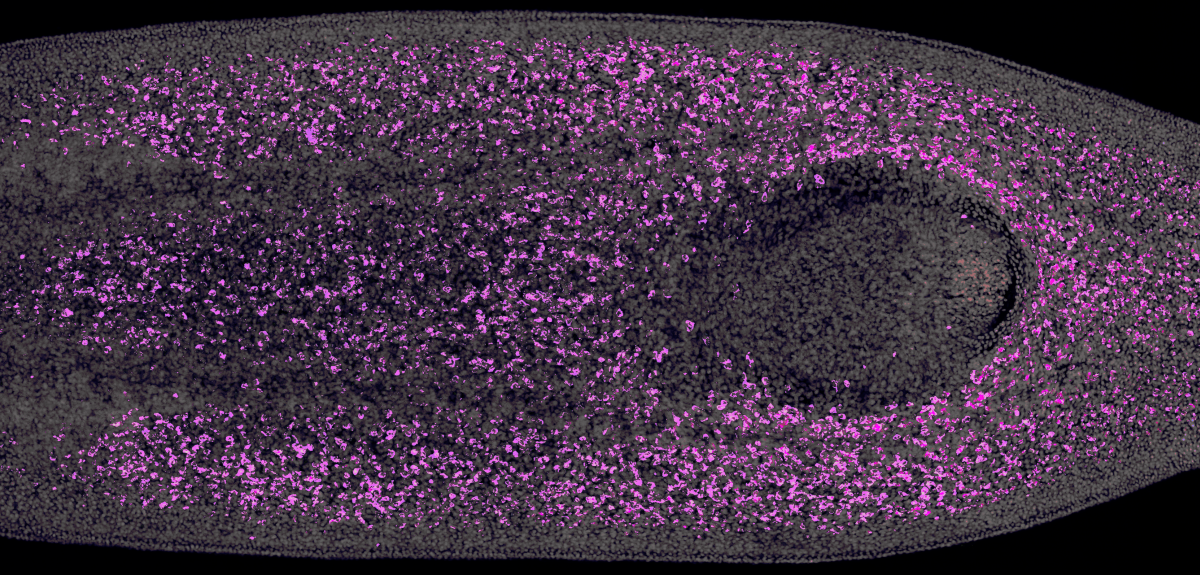
New understanding of worm stem cells could untap potential of our own
Research from Oxford University published in the journal Genome Research has found that a special combination of epigenetic modifications crucial to stem cell growth evolved in animals much earlier than previously appreciated.
These findings imply that our stem cells, and those of simple animals such as planarian worms, have much more in common at the epigenetic level than previously thought. These insights could help us enhance the use of stem cells in regenerative medicine-based approaches to treating tissues and organs damaged by disease or age.
Using the highly regenerative planarian flatworm as a test organism, the team studied epigenetic mechanism in its stem cell.
Lead author of the study, Professor Aziz Aboobaker from Oxford University’s Department of Zoology, said: ‘These worms take many people back to their childhood, thinking about superpowers and heroes. They recover from almost any damage or wound, regenerating their whole bodies from small starting fragments in about seven days. They can do this because they are chock full of very special adult stem cells that not only have the ability to generate any other cell type in the body, but do so in a controlled and organised manner that allows for whole body regeneration. Understanding how they do this is key for understanding how we might make better use of our own stem cells.’
While DNA provides the instruction manual for how life on Earth is created, how these instructions are interpreted is crucial. A process known as ‘epigenetic modifications’ - chemical modifications that decorate DNA and the histone proteins around which DNA is wrapped - is central to how these instructions are understood and followed. The coding of epigenetic modifications found at the starting blocks of genes are essential in allowing the genes to function properly. The combination of these epigenetic modifications act to mark genes either as ‘active’ or ‘silent’, therefore ensuring that sets of genes undertake the correct processes in the right cells of the body. However, when these mechanisms go wrong they can lead to genes being active or silent when they are not supposed to be. These errors are thought to underpin the progress of many diseases including cancer and the natural ageing process.
There are a subset of genes in stem cells that have a special ‘sitting on the fence’ arrangement, meaning that both active and silent marks are present at the same time. This arrangement is thought to underpin the special property of stem cells being ‘pluripotent’ (the ability to become any other type of cell in the body). These genes remain inactive in stem cells but are poised to switch on if required to do so, a state known as ‘bivalency’.
Bivalency was widely thought to be specific to complex animals such as humans and other vertebrates. However, new research led by Oxford’s Department of Zoology has shown that this process probably evolved much earlier.
Professor Aboobaker added: ‘Many groups across the world now use planarians as a model system to study stem cells and regeneration, but one important aspect of this is what extent planarian stem cells wok in the same way as our stem cells. So far the jury has been out on this, but our recent findings now suggest that they are very similar.’
In order to test whether ‘bivalency’ exists in planarian stem cells, the team sorted the stem cells from whole worms and isolated packaged DNA with epigenetic modifications intact. Using this material they then used antibodies that recognise both the activating and silencing marks and sequenced the DNA associated with them throughout the genome.
Anish Dattani, a graduate student in the Aboobaker Lab, said: ‘Our data quite clearly shows that active marks associated with the genes known to be switched on the stem cells and that silencing marks are placed at genes that are off. But the question was whether worm stem cells also had bivalency. Previous evidence from other invertebrates and simple animals suggested this was only present in mammals and fish. We then looked for genes with both marks at the same genes. Not only did we find genes with both marks, but we noticed that many of these were genes that switch on just as stem cells have made the decision to differentiate and become another cell type. This was really strong evidence that bivalency was present and doing the same thing as in our stem cells.’
Professor Aboobaker concluded: ‘The results of this approach served to confirm the team’s findings that ‘bivalency’ seems likely to have evolved earlier in multicellular animal evolution than we thought, and this adds to the growing narrative that simple worm stem cells and our stem cells have much more in common then we imagined when we started this work.’
The work, funded by the BBSRC and MRC, is part of an ongoing research program at the Aboobaker lab group at the University of Oxford.
 New study finds that ChatGPT amplifies global inequalities
New study finds that ChatGPT amplifies global inequalities
 Expert Comment: Chatbot-driven sexual abuse? The Grok case is just the tip of the iceberg
Expert Comment: Chatbot-driven sexual abuse? The Grok case is just the tip of the iceberg